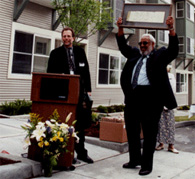 SHA Deputy Executive Director Al Levine, presents Harry Thomas with the house number from the Holly Park house where he once lived.
SHA Deputy Executive Director Al Levine, presents Harry Thomas with the house number from the Holly Park house where he once lived.
SEATTLE—March 13, 2004—The Harry Thomas story is as American as apple pie, a tale of hardship overcome and opportunities seized. Let's begin back in the 1980s.
Jennifer Potter, Chair of the SHA Board of Commissioners, remembers discussing Seattle's public housing with Thomas as they walked out of a meeting. "He remarked then ‘that when I retire, I would like to have redeveloped all the SHA family communities.'"
Recalling that moment today, Potter says "I am so pleased that when Harry retires next month, much of his dream already will have come to pass."
Potter referred to the redevelopment of NewHolly on the southern slope of Beacon Hill. Built originally as Holly Park to house defense workers during World War II, the nearly $300 million redevelopment (including $50 from Federal HOPE VI funds) is replacing 871 housing units with 1,390 units.
By any measure, the Seattle Housing Authority Thomas has led for 13 years is a major enterprise. SHA provides low-income and affordable homes for 24,000 people in a wide variety of housing types, with an annual budget of $136.7 million and more than 600 staff, 40 percent of whom are former or current SHA residents. "That SHA is held in such high esteem nationally," said Potter "is a tribute to many people, but first and foremost to Harry."
On many levels, public housing has been a way of life for Harry Thomas. He grew up there, first in the Renton Highlands then in the old Holly Park. In Renton, the Thomas family lived next door to a cemetery, in segregated housing. But to the six-year-old Harry, playing football amid the tombstones only helped him to learn broken field running.
When his father took a job in Chicago, Mother Thomas remained here and moved Harry, his younger brother Michael and sister Madeline to Holly Park. Life was tough. By night she worked the graveyard shift as a nurse's aide. By day she cleaned people's houses.
Harry looked after his siblings. Yet he still had time to play with his buddies. At nearby lumberyards they would scrounge for scrap lumber to build tree houses among the large old trees shading Holly Park. "We would build the tree houses," he recalls with a sly grin. "The SHA staff would tear them down. We'd rebuild them, bigger and higher. They would tear them down. We'd do it again. It was great fun!"
Cleveland High School provided a major turning point in young Harry's life. Two teachers in particular (Harrison Bailey in Spanish and William Brockman in Biology) took an interest in him. "They saw in me something I did not see in myself," he says. "Without them I never would have dreamed about college."
His grades up, Harry earned a major college scholarship in a tough statewide competition. Called the Vivian and Florence Carkeek Memorial Award, the scholarship provided four full years of tuition, books and a small housing allowance, all on the condition he get no grade lower than a ‘B'—he didn't.
Thomas entered the University of Washington in fall, 1959 and never looked back. He majored in sociology, already planning a career of service to the community. He was selected for the elite honors program in the Sociology Department. He worked also as newspaper curator at the University's Suzzallo library, work that furthered his education is a special way. "I would sort and distribute more than 200 newspapers each day from all over the world and in all languages. I'd even try to read the languages I couldn't begin to understand. It gave me a great new perspective about the world."
After graduation, Harry tried law school but did not take to it. He left to join Neighborhood House, a small social service agency, as a street worker focused on youths susceptible to the lure of gang activities. It was 1964.
Joining Neighborhood House brought Thomas right back to public housing. The main office was at SHA's Yesler Terrace, with a branch at Rainier Vista. War-on-Poverty money provided the funding, but mismanagement brought troubles and almost ruined the agency. Harry helped to save it—but gives the credit to "some wonderful accountants and terrific board members."
Thomas had joined Neighborhood House as one of 4 employees. At age 26, he was made executive director. Eighteen years later, when he left to become the Deputy King County Executive, Neighborhood House had 120 employees and was a thriving and respected non-profit enterprise.
As deputy to King County Executive Randy Revelle, Harry's portfolio included oversight of public housing, among the many activities of county government. He would go on to serve as SHA executive director from 1987 to 1993. Next, he answered the call from Governor Mike Lowry to be his staff director. When Lowry left office in 1997, Thomas was asked to retake the helm of SHA.
"The payback (for all that public housing has meant for me) is the realization that unless government participates in public housing, the cities will lose one of their greatest assets and people will be much worse off," says Thomas.
"The Seattle Housing Authority, the residents, the staff, our programs, all contribute much to the fabric of this city."
"For my part," says Thomas, "I must give a lot of credit to Jesse Epstein who headed SHA for so many years. I got to know him quite well. I'd pick him up during many a noon hour and we'd drive around the properties and various neighborhoods. He gave me his rich perspective on public housing and the people. It dawned on me that to be successful we needed to make those public communities much more like their surrounding neighborhoods."
Retirement will not find Harry ensconced in the proverbial rocking chair. He and wife Carol will continue their travels and love of camping and boating. Family life centered around two granddaughters, community service on boards, and adventures around Puget Sound will keep Harry Thomas busy.
With a self-deprecating wrinkle of the nose, however, Thomas volunteers that after decades of being an avid sailor, that is sail boater, he has converted to a powerboat. To him that decision may represent a compromise. To the rest of us whose boating experiences are limited to the Washington State Ferries, a salute to Captain Thomas is very much in order.
About the author
Sam Sperry is a veteran Seattle journalist who has worked in various jobs in both the public and private sector. This includes time as an editor at the Seattle Post-Intelligencer, vice-president for community affairs with the Seattle Mariners, press secretary to King County Executive Randy Revelle (where Harry Thomas was his colleague), director of the City of Seattle's energy office and Seattle Times staff reporter.
